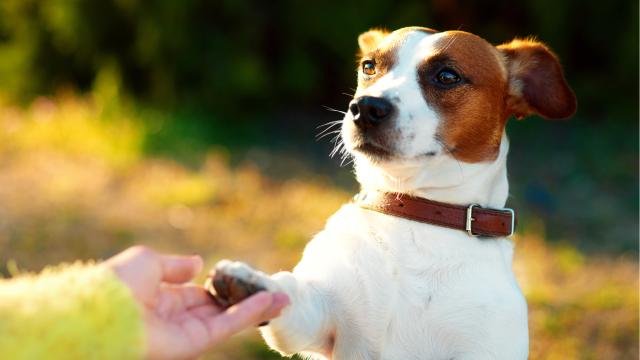Dogs are the best people, so it’s only natural to want to smother them with affection when you greet them. Most of them are too nice to say it, but this is actually a terrible way to introduce yourself to a dog. Here’s how to make a more appropriate first impression.
Dogs are a lot like us: They usually don’t want to be hugged by strangers. It’s uncomfortable and it would make you feel unsafe. Dog site Doggone safe backs this up:
Children (and adults too) often want to show love to dogs the way we show love to each other, through hugs and kisses. Dogs do not naturally understand this, or even enjoy it.
In the above video, Kristin from Indy in the Hood explains the dos and don’ts of greeting a dog for the first time. Here are the basics.
Approach the owner: When you see a dog you want to meet or you’re meeting a friend’s dog for the first time, ignore the dog and talk to the owner instead. A dog looks at his or her owner for emotional cues, so if the dog sees that the owner is comfortable with you, chances are, the dog will be comfortable with you, too. Plus, it’s just polite. Some people don’t want you smothering their dogs.
Position yourself side-by-side: Instead of coming right at the dog, position yourself side-by-side and allow the dog to approach you. You can see how it’s done in the above video.
Avoid eye contact: Eye contact can be threatening to dogs, so it’s best to find a neutral spot to focus on instead. Indy in the Hood suggests the dog’s chest area.
Let them sniff: With a closed fist, allow the dog to take a sniff and smell you. A closed hand is less threatening. If the dog sniffs and seems OK with you, you can probably pet them on the shoulder, chest or neck, which is less threatening than petting the top of the dog’s head or it’s butt.
If the dog backs away from you when you get near it, you obviously want to stop and move on. It’s just not that into you. Dogs will give you a sign that they’re done. They will move or change positions away from you. As tempting as it is to continue giving affection, it’s in the dog’s best interest for you to say goodbye and move on.
Keep in mind, even if a dog seems cool with you smothering it with love, most of them just tolerate it. Some might even bite or snap at you if you get too close. Even your own dog might not want a hug or affection. There are a couple of ways to tell if you should just leave the dog alone:
- A tucked tail: Not all tail wags are happy wags. If the tail is slow and stiff, the dog is probably alert, not excited. And if the tail is tucked and wagging, it’s a sign of fear and submission.
- Ear position: If a dog’s ears are erect and facing forward, they could be interested or aggressive. When the ears are flat against the head, they’re scared or submissive.
- Side eye: If the dog is showing the white parts of its eyes, that’s a common sign of stress.
On the other hand, you may encounter a dog that’s too affectionate. If a dog greets you by jumping on you and taking over your space, try the “Be a Tree” method. It’s a method dog safety experts teach kids to avoid aggressive dogs. You fold your branches (which are your hands), look down, and stay still for 10 seconds. I tried this on a friend’s overly affectionate dog and it worked like a charm.

Comments
3 responses to “How To Introduce Yourself To A Dog”
and how a dog should introduce itself to you…
http://i1.kym-cdn.com/entries/icons/original/000/007/447/hello-yes-this-is-dog.png
All good advice; now, what to do if a dog shows you unremitting unwanted attention, particularly when the owners couldn’t care less, refuse to call the dog off and don’t bother with a leash? Be a tree doesn’t do the job, as dog hangs around; I want it gone.
Grow a heart, you cold bastard…! ;P
Actually, the recommended advice is to simply ignore it but some of the time that’s unlikely to help. Puppers mostly act out of their experience, so if that behaviour has been permitted by its owners in the past, it’s going to think that’s ok and there’s little you can do to stop it without resorting to more extreme measures, which could put you in an awkward position and end badly, especially if you’re a stranger.
If it’s particularly badly behaved pooch, I’d be inclined to politely ask the owner to kindly rein in their pupper. If that didn’t help, you could get more insistent and use words like irresponsible, or bad-mannered; no one likes to be accused of uncouth behaviour.
If nothing else does the trick you can either advise the management of the venue at which you happen to be to deal with it (if applicable) , or grin and bear it, or just walk away.
Other than that, you gotta deal with it buddy. (•_•) ( •_•)>⌐■-■ (⌐■_■)